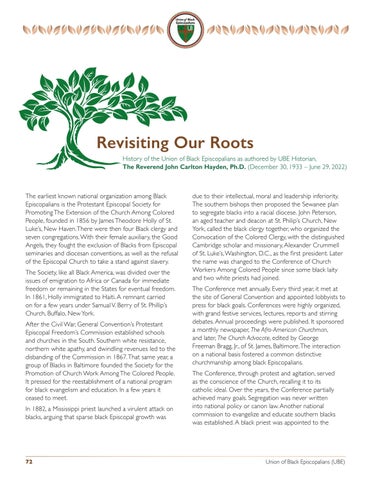Revisiting Our Roots History of the Union of Black Episcopalians as authored by UBE Historian, The Reverend John Carlton Hayden, Ph.D. (December 30, 1933 – June 29, 2022)
The earliest known national organization among Black Episcopalians is the Protestant Episcopal Society for Promoting The Extension of the Church Among Colored People, founded in 1856 by James Theodore Holly of St. Luke’s, New Haven. There were then four Black clergy and seven congregations. With their female auxiliary, the Good Angels, they fought the exclusion of Blacks from Episcopal seminaries and diocesan conventions, as well as the refusal of the Episcopal Church to take a stand against slavery. The Society, like all Black America, was divided over the issues of emigration to Africa or Canada for immediate freedom or remaining in the States for eventual freedom. In 1861, Holly immigrated to Haiti. A remnant carried on for a few years under Samual V. Berry of St. Phillip’s Church, Buffalo, New York. After the Civil War, General Convention’s Protestant Episcopal Freedom’s Commission established schools and churches in the South. Southern white resistance, northern white apathy, and dwindling revenues led to the disbanding of the Commission in 1867. That same year, a group of Blacks in Baltimore founded the Society for the Promotion of Church Work Among The Colored People. It pressed for the reestablishment of a national program for black evangelism and education. In a few years it ceased to meet. In 1882, a Mississippi priest launched a virulent attack on blacks, arguing that sparse black Episcopal growth was
72
due to their intellectual, moral and leadership inferiority. The southern bishops then proposed the Sewanee plan to segregate blacks into a racial diocese. John Peterson, an aged teacher and deacon at St. Philip’s Church, New York, called the black clergy together, who organized the Convocation of the Colored Clergy, with the distinguished Cambridge scholar and missionary, Alexander Crummell of St. Luke’s, Washington, D.C., as the first president. Later the name was changed to the Conference of Church Workers Among Colored People since some black laity and two white priests had joined. The Conference met annually. Every third year, it met at the site of General Convention and appointed lobbyists to press for black goals. Conferences were highly organized, with grand festive services, lectures, reports and stirring debates. Annual proceedings were published. It sponsored a monthly newspaper, The Afro-American Churchman, and later, The Church Advocate, edited by George Freeman Bragg, Jr., of St. James, Baltimore. The interaction on a national basis fostered a common distinctive churchmanship among black Episcopalians. The Conference, through protest and agitation, served as the conscience of the Church, recalling it to its catholic ideal. Over the years, the Conference partially achieved many goals. Segregation was never written into national policy or canon law. Another national commission to evangelize and educate southern blacks was established. A black priest was appointed to the
Union of Black Episcopalians (UBE)





